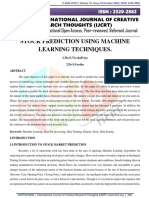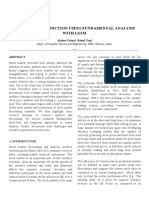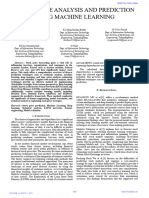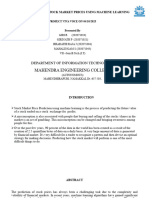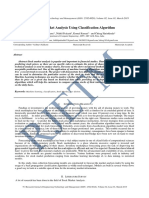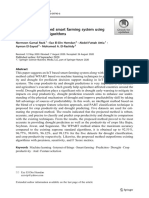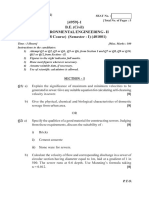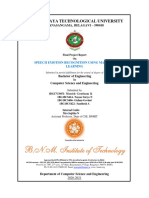Stock Market Prediction Using Machine Learning
Uploaded by
shreejaStock Market Prediction Using Machine Learning
Uploaded by
shreejaSee discussions, stats, and author profiles for this publication at: https://www.researchgate.
net/publication/331279199
Stock Market Prediction Using Machine Learning
Article in IJARCCE · January 2019
DOI: 10.17148/IJARCCE.2019.8107
CITATIONS READS
0 4,055
3 authors, including:
Yogita Deshmukh
3 PUBLICATIONS 0 CITATIONS
SEE PROFILE
All content following this page was uploaded by Yogita Deshmukh on 24 March 2021.
The user has requested enhancement of the downloaded file.
ISSN (Online) 2278-1021
IJARCCE ISSN (Print) 2319-5940
International Journal of Advanced Research in Computer and Communication Engineering
Vol. 8, Issue 1, January 2019
Stock Market Prediction
Using Machine Learning
Yogita Deshmukh1, Deepmala Saratkar2, Harshal Hiratkar3, Sudhanshu Dhopte4, Swapnil Patankar5,
Triveni Jambhulkar6, Yash Tiwari7
Assistant Professor, Computer Technology, RGCER, Nagpur, Maharashtra, India 1
U.G. Student, Computer Technology, RGCER, Nagpur, Maharashtra, India 2,3,4,5,6,7
Abstract: The stock market has always been a promising avenue for lucrative investing, but most of the profit making
depends on the analysis of the current and past market scenario followed by subsequent predictive actions. The
currently overblown market economy has given rise to numerous variables which need to be considered before making
a beneficial transaction in the stock market. Manually analysing all these variables and affecting factors is too
cumbersome and error prone. Therefore, a Machine Learning approach is best suited for analysis of such a seemingly
chaotic system. In this project we are using Machine learning, which give a prediction of various aspects of a particular
stock or an index, such as future values of the opening price, closing price, index value etc. This will help investors and
traders make better and faster decisions.
Keywords: Stock market; Prediction; Machine learning; Artificial neural network
I. INTRODUCTION
Stock Market prediction and analysis is the act of trying to determine the future value of a company stock or other
financial instrument traded on an exchange. Stock market is the important part of economy of the country and plays a
vital role in the growth of the industry and commerce of the country that eventually affects the economy of the country.
Both investors and industry are involved in stock market and wants to know whether some stock will rise or fall over
certain period of time. The stock market is the primary source for any company to raise funds for business expansions.
It is based on the concept of demand and supply. If the demand for a company's stock is higher, then the company share
price increases and if the demand for company's stock is low then the company share price decrease. Due to
involvement of many number of industries and companies, it contain very large sets of data from which it is difficult to
extract information and analyse their trend of work manually. Stock market analysis and prediction will reveal the
market patterns and predict the time to purchase stock. The successful prediction of a stock's future price could yield
significant profit. This is done using large historic market data to represent varying conditions and confirming that the
time series patterns have statistically significant predictive power for high probability of profitable trades and high
profitable returns for the competitive business investment. Machine learning is a method of data analysis that automates
analytical model building. Using algorithms that iteratively learn from data, machine learning allows computers to find
hidden insights without being explicitly programmed where to look. Application of Machine learning algorithms is
generally focused on technical analysis but incorporation of the concepts of fundamental analysis into machine learning
can be beneficial. This project tells about how various efforts have been taken in the application of Machine Learning to
Stock forecasting and also suggests new potent ideas that can be worked upon. Recently, a lot of interesting work has
been done in the area of applying Machine Learning Algorithms for analysing price patterns and predicting stock prices
and index changes. Most stock traders nowadays depend on Intelligent Trading Systems which help them in predicting
prices based on various situations and conditions, thereby helping them in making instantaneous investment decisions.
II. LITERATURE SURVEY
In the last few decades forecasting of stock returns has become an important field of research. In most of the cases the
researchers had attempted to establish a linear relationship between the input macroeconomic variables and the stock
returns. After the discovery of nonlinearity in the stock market index returns, many literatures have come up in
nonlinear statistical modelling of the stock returns, most of them required that the nonlinear model be specified before
the estimation is done. But since stock market return is noisy, uncertain, chaotic and nonlinear in nature, ANN has
evolved out to be better technique in capturing the structural relationship between a stock’s performance and its
determinant factors more accurately than many other statistical techniques. In literature, different sets of input variables
are used to predict stock returns. In fact, different input variables are used to predict the same set of stock return data.
Copyright to IJARCCE DOI 10.17148/IJARCCE.2019.8107 31
ISSN (Online) 2278-1021
IJARCCE ISSN (Print) 2319-5940
International Journal of Advanced Research in Computer and Communication Engineering
Vol. 8, Issue 1, January 2019
Some researchers used input data from a single time series where others considered the inclusion of heterogeneous
market information and macro-economic variables. Some researchers even pre-processed these input data sets before
feeding it to the ANN for forecasting.
III. RELATED WORK
Min and Lee [1] were doing prediction of bankruptcy using machine learning. They evaluated methods based on
Support Vector Machine, multiple discriminant analysis, logistic regression analysis, and three-layer fully connected
back-propagation neural networks. Their results indicated that support vector machines outperformed other approaches
Lee was trying to predict credit rating of a company using support vector machines. They used various financial
indicator and ratios such as interest coverage ratio, ordinary income to total assets, Net income to stakeholders’ equity,
current liabilities ratio, etc. and achieved accuracy of around 60%. Predicting credit rating of the companies were also
studied using neural networks achieving accuracy between 75% and 80% for the United States and Taiwan markets
Tsai and Wang
[2] Did a research where they tried to predict stock prices by using ensemble learning, composed of decision trees and
artificial neural networks. They created dataset from Taiwanese stock market data, taking into account fundamental
indexes, technical indexes, and macroeconomic indexes. The performance of Decision Tree + Artificial Neural Network
trained on Taiwan stock exchange data showed F-score performance of 77%. Single algorithms showed F-score
performance up to 67%.Kim and Han
[3] Guresen et al. (2011) describe ANN as one of the best techniques to model the stock market, because it does not
contain standard formulas and may be easily adapted to market changes. ANN have the ability to learn by example and
make interpolations and extrapolations of what they learned. The use of ANN in the solution of a task initially involves
a learning phase, which is when the network extracts the patterns, thereby creating a specific representation of the
problem (Braga, Carvalho, & Ludermir, 2007).
The first model for prediction of stock price based on ANN was developed by White (1988). The author used a feed
forward network to detect unknown regularities in stock price changes. The goal was to analyze the daily returns of
IBM stock in order to test the efficient market theory, proposed by Fama (1970), which states that stock prices follow a
random walk. Although he has not obtained good predictive results, the research stressed the potential for such analysis.
Since then, a large number of researchers have actively participated in the development of predictive models that may
be reliably applied in the stock market.
[4] Stock Market prediction has been one of the more active research areas in the past, given the obvious interest of a
lot of major companies. In this research several machine learning techniques have been applied to varying degrees of
success. However, stock forecasting is still severely limited due to its non-stationary, seasonal and in general
unpredictable nature. Stock Market Prediction Using Hidden Markov Models Aditya Gupta, Non-Student Member,
IEEE and Bhuwan Dhingra, Non-Student member, IEEE T Predicting forecasts from just the previous stock data is an
even more challenging task since it ignores several outlying factors (such as the state of the company, economic
conditions ownership etc.)
[5] A later study conducted by Tsibouris and Zeidenberg (1995) tests the efficient market theory by analyzing six stocks
of the US stock exchange, finding a capacity to predict prices based on historical series of prices. Other studies, such as
(Kolarik & Rudorfer, 1994; Refenes, 1991; Refenes, Azema-Barac, & Zapranis, 1993), observed that ANN obtain
better prediction performance comparable to statistical techniques, such as the regression model and those obtained by
ARIMA technique.
IV. PROPOSED SYSTEM
The proposed model is based on the study of historical data, technical indicators and optimizing neural network
algorithm to be used in the prediction of daily stock prices. The proposed model architecture contains six inputs vectors
represent the historical data and derived technical indicators and one output represents next price. The following steps
were used to build a neural model capable of making predictions of stocks closing prices short term future behaviour:
(1) understanding of the problem domain and identification of key variables;
(2) pre-selection and collection of samples;
(3) pre-processing of inputs;
(4) Modelling and prediction.
Copyright to IJARCCE DOI 10.17148/IJARCCE.2019.8107 32
ISSN (Online) 2278-1021
IJARCCE ISSN (Print) 2319-5940
International Journal of Advanced Research in Computer and Communication Engineering
Vol. 8, Issue 1, January 2019
Fig. 1Proposed System
Fig. 1 shows the proposed architecture of the system. Artificial Neural Network (ANN) is an information processing
system where the elements called neurons, process the information. The signals are transmitted by means of connection
links. The links possess an associated weight, which is multiplied along with the incoming signal (net input) for any
typical neural network. The output signal is obtained by applying activations to the net input. The network consists of a
set of sensory units that constitute the input layer and one or more hidden layer of computation modes. The input signal
passes through the network in the forward direction. This type of network is called as multilayer perception (MLP). The
multilayer perception are used with supervised learning and have to lead the successful back propagation algorithm
where logistic sigmoid function is widely used. The MLP network has hidden neurons and this will make the network
more active for complex tasks. The layers of network are connected by synaptic weights and have a high computational
efficiency.
V. METHODOLOGY OF BUILDING A PREDICT MODEL
General steps of building and predicting the value by using Multi Layer Perception model in the Neural Works Predict.
1. Building a Predict Model: To make predictions from data if target outputs can be any value in a
Continuous range of numeric values or a discrete ordered range of numeric values.
2. Selection of model: Multi Layer Perception (MLP) model is selected to predict the stock value.
3. MLP Input training data
4. MLP Output training data
5. MLP Training data characteristics
6. MLP Network parameters
7. Reviewing parameters and training the model
8. Saving the model
9. Training statistics
10. Testing a predict model
11. Specifying data sets for testing
12. Interpreting test results
13. Running a MLP predict model
VI. RESULTS
Fig. 2 shows an example of an image with adequate resolution of Artificial Neural Network. A neural network is a
model characterized by an activation function, which is used by interconnected information processing units to
transform input into output. The first layer of the neural network of the neural network receives the raw input, process it
and passes the processed information to the hidden layer.
Copyright to IJARCCE DOI 10.17148/IJARCCE.2019.8107 33
ISSN (Online) 2278-1021
IJARCCE ISSN (Print) 2319-5940
International Journal of Advanced Research in Computer and Communication Engineering
Vol. 8, Issue 1, January 2019
Fig. 2.Artificial Neural Network
Fig 3(i) Fig 3(ii)
Fig. 3(i) & 3(ii).Stock Prediction Graph
In Fig 3(i) &3(ii) shows the prediction graph using neural network. The data is of Tata Motors whereas in fig 3(i)
shows the opening price from the Jan 2016 till Jan 2019. And the fig 3(ii) shows the closing price of Tata Motors.
The data has been accessed from yahoo server.
CONCLUSION
In this research, we sought to understand the set of information present in the financial market and identify the variables
that drive stock prices, taking into account the activities performed and economy sectors, the various industry,
macroeconomic and market indicators. The methodology presented may be adapted to other enterprises and their
stocks. Theoretically, the discussion on the predictions of stock prices is still controversial and unproductive. However,
from the empirical standpoint, this research proved to be very productive, with some methods for financial market
prediction being developed and demonstrated. Predicting the direction into which stock prices change is very important
for the development of effective strategies to operate in the stock market. The result of the questionnaire applied to
qualified respondents revealed that 80% of the respondents believe that the models and methods they use are
satisfactory, but they do not use computer techniques to operate in the stock market. The assertive prediction of stock
prices may promise attractive benefits for investors in general. In general, the results were satisfactory as they
successfully achieved the objective of this research to predict the closing price. Thus, the use of ANN to predict the
behavior and trends of stocks has shown to be a feasible alternative to conventional techniques, revealing the market
behavior and offering privileged information to investors, in addition to the possibility of being used in combination
with other techniques.
Copyright to IJARCCE DOI 10.17148/IJARCCE.2019.8107 34
ISSN (Online) 2278-1021
IJARCCE ISSN (Print) 2319-5940
International Journal of Advanced Research in Computer and Communication Engineering
Vol. 8, Issue 1, January 2019
FUTURE SCOPE
Neural networks often lead to significant results, e.g. in weather forecasting, a rule of weather change is less probable
than a steady weather pattern. This is also true for stock prices. A key aspect to successful forecasting lies in the ability
to merge data available in diverse formats . The data analysis performed by neural networks tolerates a considerable
amount of imprecise and incomplete input data due to the distributed mode of information processing. Neural network
lie in their ability to predict accurately even in situations with uncertain data, and the possible combinations with other
methods. Despite the benefits of artificial neural networks, there are still some limitations to neural networks that are
discussed below. Some methods are executed with insufficient reliability tests, data design and with inability to identify
the optimal topology for a specific problem domain. There is no known method of designing an optimal neural network,
but the best network is highly dependent on the data and application.
Some of the limitations are mentioned below:
1. NN require very large number of previous data.
2. The best NN architecture topology is still unknown.
3. For complex networks the result and accuracy may decrease.
4. Statistical relevance of the result is needed.
5. More careful data design is needed and systematically analyzed.
In order to improve the NN applications, there are some other limitations, concerning the problems of evaluation and
implementation of NN that should be discussed. Large number of research is done and implemented by companies that
are not published in scientific indexes.
ACKNOWLEDGMENT
We take an opportunity to acknowledge and extend our gratitude to our Project Guide Prof. Yogita Deshmukh
Professor of Computer Technology, RGCER, Nagpur. She has helped us in many ways. Her enthusiastic engagements
in our project work and her never-ending stream of ideas have been absolutely essential for the results, presented here.
We are very grateful that she has spent so much time with us discussing different problems ranging from philosophical
issues down to minute technical details. We would also like to express our sincere thanks to Prof. Yogita Deshmukh
Asst. Professor of CT, Rajiv Gandhi College of Engineering and Research, Nagpur for her Guidance and kind support.
We express our deepest sense of gratitude to Dr. Manali Kshirsagar, Principal, RGCER, Nagpur.
We also extend our thanks to all the faculty members of the department for providing their cooperation. Finally, we
would like to thanks to everybody who has directly or indirectly contributed to our project work.
REFERENCES
[1]. K. Tsai and J. Wang, "External technology sourcing and innovation performance in LMT sectors", Research Policy, vol. 38, no. 3, pp. 518-526, 2009.
[2]. K. Han and J. Kim, "Genetic quantum algorithm and its application to combinatorial optimization problem", Evolutionary Computation, 2000,
vol. 2, pp. 1354-1360, 2000.
[3]. Atsalakis, G. S., Dimitrakakis, E. M., & Zopounidis, C. D. (2011). Elliott wave theory and neuro- fuzzy systems, in stock market prediction:
The WASP system. Expert Systems with Applications, 38, 9196–9206
[4]. Olivier C., Blaise Pascal University: “Neural network modeling for stock movement prediction, state of art”. 2007
[5]. Leng, X. and Miller, H.-G. : “Input dimension reduction for load forecasting based on support vector machines”, IEEE International
Conference on Electric Utility Deregulation, Restructuring and Power Technologies (DRPT2004), 2004.
[6]. Chun C, Qinghua M, Shuqiang L.: “Research on Support Vector Regression in the Stock Market Forecasting” ©Springer, Advances in
Intelligent and Soft Computing Volume 148, , pp 607-612, 2012.
[7]. Guo Z., Wang H., Liu Q. : “Financial time series forecasting using LPP and SVM optimized by PSO” © Springer, Soft Computing
Methodologies and Applications , December 2012.
[8]. Tsibouris, G., & Zeidenberg, M. (1995). Testing the efficent markets hypothesis with gradient descent algorithms. In R A (Ed.), Neural
networks in the capital markets.John Wiley and Sons.
[9]. Guresen, E., Kayakutlu, G., & Daim, T. U. (2011). Using artificial neural network models in stock market index prediction. Expert Systems
with Applications, 38(8), 10389–10397.
[10]. Gupta, A. :“Stock market prediction using Hidden Markov Models”, IEEE Engineering and Systems (SCES), 2012 Students Conference on,
pp.1-4, 2012.
Copyright to IJARCCE DOI 10.17148/IJARCCE.2019.8107 35
View publication stats
You might also like
- Waste Collection Amp Segregation Using Computer Vision and Convolutional Neural Network For VesselsNo ratings yetWaste Collection Amp Segregation Using Computer Vision and Convolutional Neural Network For Vessels6 pages
- Stock Market Prediction Using Machine LearningNo ratings yetStock Market Prediction Using Machine Learning5 pages
- Stock Market Analysis using Machine LearningNo ratings yetStock Market Analysis using Machine Learning9 pages
- Stock Market Prediction Using Machine Learning AlgorithmsNo ratings yetStock Market Prediction Using Machine Learning Algorithms7 pages
- A Systematic Analysis of Stock Prediction Models using Artificial Intelligence ApproachesNo ratings yetA Systematic Analysis of Stock Prediction Models using Artificial Intelligence Approaches17 pages
- STOCK MARKET PREDICTION USING MACHINE LEARNINGNo ratings yetSTOCK MARKET PREDICTION USING MACHINE LEARNING1 page
- Stock Market Prediction Using Machine Learning: Gareja Pradip, Chitrak Bari, J. Shiva NandhiniNo ratings yetStock Market Prediction Using Machine Learning: Gareja Pradip, Chitrak Bari, J. Shiva Nandhini4 pages
- Predictive Modeling of Stock Prices Using Transformer ModelNo ratings yetPredictive Modeling of Stock Prices Using Transformer Model8 pages
- Kishan Giri Final Project Report - KISHAN GIRI PDFNo ratings yetKishan Giri Final Project Report - KISHAN GIRI PDF47 pages
- Stock Prediction Using Machine Learning Google ScholarNo ratings yetStock Prediction Using Machine Learning Google Scholar8 pages
- Stock Price Analysis and Prediction Using Machine Learning 2No ratings yetStock Price Analysis and Prediction Using Machine Learning 26 pages
- ASHOK Visualising Forecasting Stock Using Dashboard ProjectNo ratings yetASHOK Visualising Forecasting Stock Using Dashboard Project75 pages
- Soni 2022 J. Phys. Conf. Ser. 2161 012065No ratings yetSoni 2022 J. Phys. Conf. Ser. 2161 01206511 pages
- Stock Market Prediction Using Time Series: ArticleNo ratings yetStock Market Prediction Using Time Series: Article5 pages
- Prediction of Stock Market Prices Using Machine Learning-1No ratings yetPrediction of Stock Market Prices Using Machine Learning-117 pages
- Stock Analysis Prediction Python ReportNo ratings yetStock Analysis Prediction Python Report83 pages
- Sustainable Stock Market Prediction Framework UsinNo ratings yetSustainable Stock Market Prediction Framework Usin15 pages
- lawal2020 Stock Market Prediction using Supervised Machine Learning Techniques An OverviewNo ratings yetlawal2020 Stock Market Prediction using Supervised Machine Learning Techniques An Overview7 pages
- (IJCST-V10I5P49) :mrs R Jhansi Rani, C NithinNo ratings yet(IJCST-V10I5P49) :mrs R Jhansi Rani, C Nithin8 pages
- Stock Market Prediction Based On Machine LearningNo ratings yetStock Market Prediction Based On Machine Learning27 pages
- Stock Market Prediction Using Machine Learning Algorithms A Classification StudyNo ratings yetStock Market Prediction Using Machine Learning Algorithms A Classification Study4 pages
- A Systematic Literature Review Forecasting Stock Price Using Machine Learning ApproachNo ratings yetA Systematic Literature Review Forecasting Stock Price Using Machine Learning Approach5 pages
- Stock Market Analysis Using Classification Algorithm PDFNo ratings yetStock Market Analysis Using Classification Algorithm PDF6 pages
- Stock Market Prediction Using Machine Learning: December 2018No ratings yetStock Market Prediction Using Machine Learning: December 20184 pages
- Khushi Final Project Stock (1) - NumberedNo ratings yetKhushi Final Project Stock (1) - Numbered67 pages
- Optimization of HVAC System Energy Consumption in A Building Using Artificial Neural Network and Multi-Objective Genetic AlgorithmsNo ratings yetOptimization of HVAC System Energy Consumption in A Building Using Artificial Neural Network and Multi-Objective Genetic Algorithms10 pages
- Cambricon: An Instruction Set Architecture For Neural NetworksNo ratings yetCambricon: An Instruction Set Architecture For Neural Networks13 pages
- Defense_Strategies_for_Epidemic_Cyber_Security_Threats_Modeling_and_Analysis_by_Using_a_Machine_Learning_ApproachNo ratings yetDefense_Strategies_for_Epidemic_Cyber_Security_Threats_Modeling_and_Analysis_by_Using_a_Machine_Learning_Approach27 pages
- Implementing Pointnet For Point Cloud Segmentation in The Heritage ContextNo ratings yetImplementing Pointnet For Point Cloud Segmentation in The Heritage Context18 pages
- 22n01f0038-Deep Side A Deep Learning Framework For Drug Side Effect PredictionNo ratings yet22n01f0038-Deep Side A Deep Learning Framework For Drug Side Effect Prediction36 pages
- Deep Neural Networks For Spectrum Sensing A ReviewNo ratings yetDeep Neural Networks For Spectrum Sensing A Review25 pages
- Prediction of Penetration Rate in Drilling Operations: A Comparative Study of Three Neural Network Forecast MethodsNo ratings yetPrediction of Penetration Rate in Drilling Operations: A Comparative Study of Three Neural Network Forecast Methods14 pages
- 19EEE362:Deep Learning For Visual Computing: Dr.T.AnanthanNo ratings yet19EEE362:Deep Learning For Visual Computing: Dr.T.Ananthan23 pages
- Data Science Deep Learning & Artificial IntelligenceNo ratings yetData Science Deep Learning & Artificial Intelligence9 pages
- Implementing Chatbots Using Neural Machine Translation TechniquesNo ratings yetImplementing Chatbots Using Neural Machine Translation Techniques44 pages
- 1-D CNNs For Structural Damage Detection Verification On A Structural Health Monitoring Benchmark DataNo ratings yet1-D CNNs For Structural Damage Detection Verification On A Structural Health Monitoring Benchmark Data10 pages
- Sugarcane Disease Detection Using Data Mining TechniquesNo ratings yetSugarcane Disease Detection Using Data Mining Techniques6 pages
- Arrangementnet: Learning Scene Arrangements For Vectorized Indoor Scene ModelingNo ratings yetArrangementnet: Learning Scene Arrangements For Vectorized Indoor Scene Modeling15 pages
- Machine Learning Algorithms For Stock Market PredictionNo ratings yetMachine Learning Algorithms For Stock Market Prediction3 pages
- The Mass Appraisal of The Real Estate by Computational IntelligenceNo ratings yetThe Mass Appraisal of The Real Estate by Computational Intelligence6 pages
- Waste Collection Amp Segregation Using Computer Vision and Convolutional Neural Network For VesselsWaste Collection Amp Segregation Using Computer Vision and Convolutional Neural Network For Vessels
- Stock Market Prediction Using Machine Learning AlgorithmsStock Market Prediction Using Machine Learning Algorithms
- A Systematic Analysis of Stock Prediction Models using Artificial Intelligence ApproachesA Systematic Analysis of Stock Prediction Models using Artificial Intelligence Approaches
- Stock Market Prediction Using Machine Learning: Gareja Pradip, Chitrak Bari, J. Shiva NandhiniStock Market Prediction Using Machine Learning: Gareja Pradip, Chitrak Bari, J. Shiva Nandhini
- Predictive Modeling of Stock Prices Using Transformer ModelPredictive Modeling of Stock Prices Using Transformer Model
- Kishan Giri Final Project Report - KISHAN GIRI PDFKishan Giri Final Project Report - KISHAN GIRI PDF
- Stock Prediction Using Machine Learning Google ScholarStock Prediction Using Machine Learning Google Scholar
- Stock Price Analysis and Prediction Using Machine Learning 2Stock Price Analysis and Prediction Using Machine Learning 2
- ASHOK Visualising Forecasting Stock Using Dashboard ProjectASHOK Visualising Forecasting Stock Using Dashboard Project
- Stock Market Prediction Using Time Series: ArticleStock Market Prediction Using Time Series: Article
- Prediction of Stock Market Prices Using Machine Learning-1Prediction of Stock Market Prices Using Machine Learning-1
- Sustainable Stock Market Prediction Framework UsinSustainable Stock Market Prediction Framework Usin
- lawal2020 Stock Market Prediction using Supervised Machine Learning Techniques An Overviewlawal2020 Stock Market Prediction using Supervised Machine Learning Techniques An Overview
- Stock Market Prediction Using Machine Learning Algorithms A Classification StudyStock Market Prediction Using Machine Learning Algorithms A Classification Study
- A Systematic Literature Review Forecasting Stock Price Using Machine Learning ApproachA Systematic Literature Review Forecasting Stock Price Using Machine Learning Approach
- Stock Market Analysis Using Classification Algorithm PDFStock Market Analysis Using Classification Algorithm PDF
- Stock Market Prediction Using Machine Learning: December 2018Stock Market Prediction Using Machine Learning: December 2018
- Optimization of HVAC System Energy Consumption in A Building Using Artificial Neural Network and Multi-Objective Genetic AlgorithmsOptimization of HVAC System Energy Consumption in A Building Using Artificial Neural Network and Multi-Objective Genetic Algorithms
- Cambricon: An Instruction Set Architecture For Neural NetworksCambricon: An Instruction Set Architecture For Neural Networks
- Defense_Strategies_for_Epidemic_Cyber_Security_Threats_Modeling_and_Analysis_by_Using_a_Machine_Learning_ApproachDefense_Strategies_for_Epidemic_Cyber_Security_Threats_Modeling_and_Analysis_by_Using_a_Machine_Learning_Approach
- Implementing Pointnet For Point Cloud Segmentation in The Heritage ContextImplementing Pointnet For Point Cloud Segmentation in The Heritage Context
- 22n01f0038-Deep Side A Deep Learning Framework For Drug Side Effect Prediction22n01f0038-Deep Side A Deep Learning Framework For Drug Side Effect Prediction
- Deep Neural Networks For Spectrum Sensing A ReviewDeep Neural Networks For Spectrum Sensing A Review
- Prediction of Penetration Rate in Drilling Operations: A Comparative Study of Three Neural Network Forecast MethodsPrediction of Penetration Rate in Drilling Operations: A Comparative Study of Three Neural Network Forecast Methods
- 19EEE362:Deep Learning For Visual Computing: Dr.T.Ananthan19EEE362:Deep Learning For Visual Computing: Dr.T.Ananthan
- Data Science Deep Learning & Artificial IntelligenceData Science Deep Learning & Artificial Intelligence
- Implementing Chatbots Using Neural Machine Translation TechniquesImplementing Chatbots Using Neural Machine Translation Techniques
- 1-D CNNs For Structural Damage Detection Verification On A Structural Health Monitoring Benchmark Data1-D CNNs For Structural Damage Detection Verification On A Structural Health Monitoring Benchmark Data
- Sugarcane Disease Detection Using Data Mining TechniquesSugarcane Disease Detection Using Data Mining Techniques
- Arrangementnet: Learning Scene Arrangements For Vectorized Indoor Scene ModelingArrangementnet: Learning Scene Arrangements For Vectorized Indoor Scene Modeling
- Machine Learning Algorithms For Stock Market PredictionMachine Learning Algorithms For Stock Market Prediction
- The Mass Appraisal of The Real Estate by Computational IntelligenceThe Mass Appraisal of The Real Estate by Computational Intelligence















